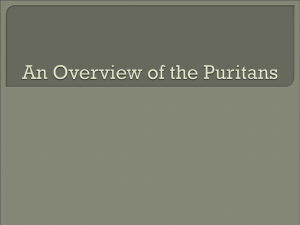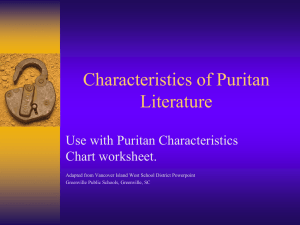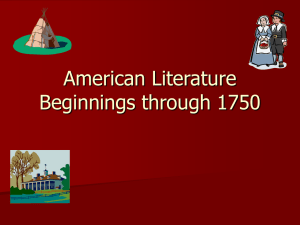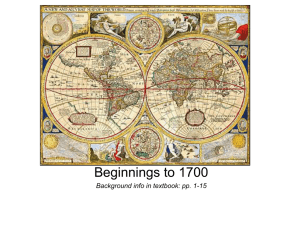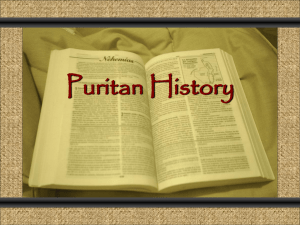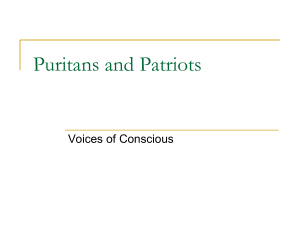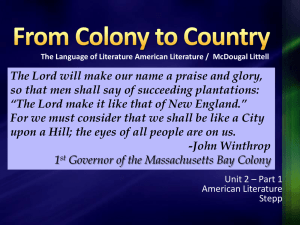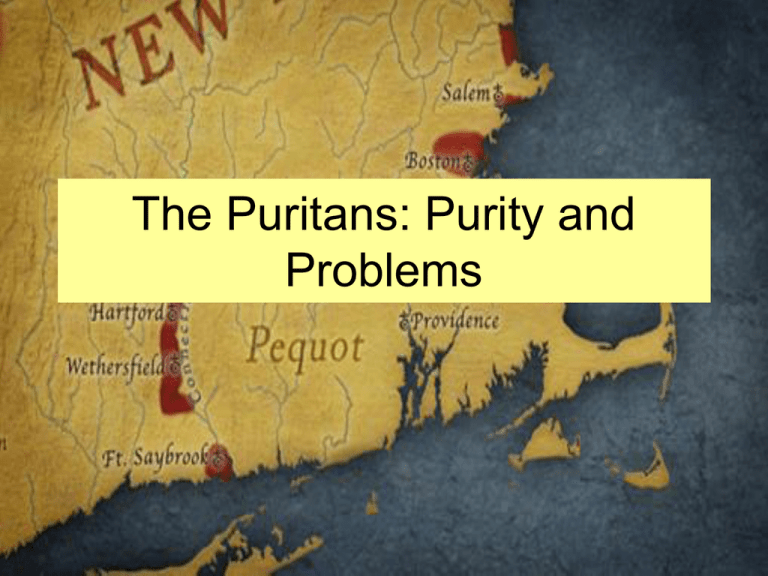
The Puritans: Purity and
Problems
Goals of Lessons
• Increase student engagement, discussion,
and retention through various methods:
– Engaging readings and sources
– Online writing and discussion prior to class
– Interactive powerpoint presentation – student
input, credit for insights, use of student work
in presentation
– In-class group discussions
– In-class readings and comments
– Continuity of themes and issues
Student Outcomes
• Make learning outcomes a natural part of
everyday work:
– Critical Thinking Skills
•
•
•
•
Use and evaluation of historical documents
Summary of argument
Analysis of argument
Comparison of multiple arguments or documents
– Communication – oral, written, group, individual
– Global Awareness
• Atlantic economic system
• Atlantic migration and immigration networks
• Atlantic political and religious networks
Student Outcomes (continued)
Race, Gender, Ethnicity:
• Issues of race and slavery
• Role of Native Americans in American life
Cultural Awareness:
• Religious diversity and intolerance
• Native American cultural, econ., enviro. practices
Hypothetical Student Contributions
• Insights from Online Group Discussion =
Highlighted in Red
• Filled in during class = Highlighted in Blue
Readings and Assignments
• Lesson #1: Puritan Religious and Social
Values
• Completed before class:
– Document: John Cotton, “The Divine Right to Occupy
the Land,” 1630
– Document: John Winthrop, “A Modell of Christian
Charity,” 1630
– Document: John Cotton, “God Did Not Ordain
Democracy Fit for Church or Commonwealth,” 1636
– Document: Massachusetts Proscribes Quakers, 1677
– Document: Roger Williams Responds to John
Cotton, 1644
– Transcript (excerpts), Trial of Anne Hutchinson
Group Journal Assignments
• Assignment: Before 8pm the night before class, read the
poem for your group. Then write at least 4 sentences
summarizing the main idea of the poem and how you
think the poem can help us understand Puritan life and
beliefs. Do you see any conflict between Bradstreet’s
views on life and those espoused in the other
documents? Provide evidence from documents to
support your case. Then respond critically to another
group member’s comments in at least 2 sentences.
• Group One: Anne Bradstreet, “Verses upon the Burning
of Our House“
• Group Two: Bradstreet, “Before the Birth of One of Her
Children“
• Group Three: Bradstreet, “To My Dear and Loving
Husband”
• Group Four: Bradstreet, “A Letter to Her Husband,
Absent Upon Public Employment"
Brainstorming
George Henry Boughton, “The Early Puritans of New England
Going to Church,” 1867
Thoughts on the Painting?
• What message was the artist trying to
convey about the Puritans?
– Positive portrayal; tight-knit community;
religious devotion; families; male leaders;
religious leadership; belief despite harsh
environment
• Does the painting contain any indication of
problems or conflicts in Puritan life?
– Look unhappy; have to carry guns for
protection on way to church; fear of attack?;
bad relations with Indians
Major Themes & Questions
•
•
•
•
•
•
Who were the Puritans?
What did they believe?
Why did they come to North America?
Differences from Chesapeake settlers?
The Puritan Covenants – Inclusion and Exclusion
Conflicts between purity and living in the “real
world”
–
–
–
–
Religious conflicts – inclusion and exclusion
Land Hunger & Conflicts with Native Americans
Economic issues and problems
Conflicts with England
Puritan Religious Beliefs
Christianity in England
Catholic Church
Church of England (Henry VIII)
Pilgrims
(Separatists)
Puritans
(Non-separatists)
Anglicans
Goals of Purification
• Puritans part of longer Protestant Reformation
• Puritans wanted to apply John Calvin’s
principles to purify Anglican Church
– More Biblical, literal interpretation of Bible
– Rejected hierarchy of Catholic Church – “popish” –
no one should get between individual and God
– Rejected rituals
– Rejected trends in English society – crime,
commerce, lack of tradition
– They liked Anglican break with Catholic Church, but
believed A.C. was corrupt – thought they could reform
A.C. from within
– Charles I & Anglicans persecuted Puritans for
criticisms – pushed them to North America and
Europe
First Euro Settlers in MA Colony
• Comparing Pilgrims and Puritans
• Pilgrims (separatists) first settlers in 1620, but
few in number
• Plymouth Plantation was a backwater
• Puritan Great Migration began in 1630
• 40,000 colonists in decade, so dominated colony
• Puritans formed a joint stock company –
Massachusetts Bay Co.
• Left meeting place blank, so held meetings in
New England to get away from English control
Puritan Beliefs
• Original sin – humans born sinful – “In Adam’s
Fall, We Sinned All” in N.E. schoolbooks
• Predestination – John Calvin – God had plan
for all humans, but it was unknown to all
– God only chose some people to be saved from Hell
– One could live well, have revelatory experience (God
revealed), then prob. going to heaven – but still up to
God
• Puritans adapted Calvin’s beliefs – God was
rational – one could be pretty sure of salvation
• Life on earth would be good indicator of
salvation – live religious life, work hard
• Puritan diaries filled with angst about whether
they would be chosen for heaven
Puritans vs. Chesapeake:
Based on what you learned about the Chesapeake
colonies, how would you compare Puritan MA?
Puritans
• Puritans focused on
controlling behavior while
on earth – punishment on
earth for bad behavior
• Puritans more religiously
motivated
• Required to go to Church
• No separation of Church
and state
• Migrated as families and
lived longer
• More healthy enviro.
Chesapeake
• Profit motive
• Individualism
• Religion not as central
• Dispersed settlements
• Majority of population
were indentured servants
• Free-wheeling in first
generations
• Gender imbalance
• Unhealthy enviro., death
normal thing
Puritan Migration
• Puritans came as families, multiple
generations
• More balanced sex ratio than Chesapeake
• Lower mortality rates – 1st generation = 72 yrs
old
• Healthier environment, less disease
• 7/8 of children reached adulthood
• Compare to Chesapeake migration and
settlement
Puritan Settlement and the Land
• John Cotton, “The Divine Right to Occupy the
Land,” 1630
–
–
–
–
–
God gives land to chosen people
People placed on land – passive
Justified war against heathens
Vacant land or unused can be taken
Migration and settlement justified to ‘gain knowledge’,
profit economically, use talents, or plant a
colony/church
– To flee persecution or debts
• Thoughts? Criticisms?
Covenant: Puritan Migration,
Settlement, and Leadership
• John Winthrop, “A Modell of Christian Charity,”
1630
• Covenants on diff. levels: bound family,
community, group, classes, and God together
• Different forms of covenantal bonds in
Winthrop’s “Modell”?
– Between Puritans and God – success = God’s
approval
– Covenant between individual and God – Christian life,
belief = good hope for salvation (heaven)
– Covenant of settlement and migration
– City Upon a Hill – symbol to Europe
– Covenant between leaders and led; wealthy and poor
Family Covenant
• Family Life
– Patriarchal family – man was head of household;
women expected to marry and have children;
unmarried looked down upon or spurned
– Relationships between husband and wife?
(Bradstreet poems)
•
•
•
•
Loving, companionate marriage
Focus on earthly love and devotion
Women’s role = family, home, religious devotion
Pride in children and growth of family
– Conflicts between love and patriarchy?
Covenant & The Land
Relationship between covenant and settlement on
land:
– Puritans wanted competency – enough land to live
on – focus on subsistence at first, not as much on
profits for self or king
– But not equality – prominent deserved more land
– Focus on community – town decided which land
would be used, worked on what day
– Town meeting – at first, only elect (saved) voted, had
best interests of community
– Covenant bound church and community members to
town and land
– Focus on benefits to included members – keeping
out excluded “others”
– Different methods of settlement than Chesapeake
Democracy in MA?
• Based on the document readings, do you
think MA was a democracy? (Cotton,
Winthrop)
• Why or why not?
Trouble on the City on a Hill
• Religious dissenters – problems of
inclusion and exclusion, purity and
tolerance
• Land Hunger – conflicts with Native
Americans
• Economic problems
• Relations with England/Crown
• Question: What issues or problems
strengthened the Puritan covenant?
Which weakened it?
Roger Williams
• Roger Williams – critical of Puritan leadership
and values – raised issues of P exclusion and
intolerance
– Believed to be more dangerous b/c he was a minister
– Disagreed with church leadership on relationship
between church and state
– Believed in toleration – people shouldn’t be forced to
join or attend church
– Exclusion was wrong
– Disagreed on treatment and relations with Native
Americans
– Williams believed N.A. deserved respect; relations of
peace; bargaining or buying of land
– Williams banished from MA in 1636; founded R.I. in
1644
Anne Hutchinson
• Came to MA in 1634, was
a midwife and educated
by father
• Held religious meetings in
her home and discussed
sermons of ministers
• Accused of heresies:
teaching men, evaluating
ministers’ beliefs,
antinomianism (belief that
God was talking directly to
individuals)
• Banished from MA
Anne Hutchinson
• Trial transcript
• Major issues?
– Women’s role in church
– Male dominated
– Who has right to relate to
God? Interpret God’s will or
message?
– Tradition vs. change
– Maintaining purity through
exclusion
– Can community or covenant
remain strong with dissent?
Salem Witch Trials, 1692
• Combination of social, economic, religious, and cultural
factors led to witch hunt and trials
• Puritan belief in witches not unique, but heightened focus on
outcasts, women, poor – exclusionary tendency in Puritan
life
• Focus on conformity, correct women’s roles in society
• Heightened surveillance of others b/c of frontier Indian war and
commercial development – suspicion of others, constant rumors
• Tituba, a slave, crystal ball, hysterical young women accused T of
being witch
• Two Sarahs (Goode and Osgoode) accused of casting spells, one
typical outcast, the other an argumentative woman - outsiders
• Tituba confessed and accused dozens of others
• 48 people claimed spells put on them
• 200 accused; 50 confessed – why? -- Confessors wouldn’t be
executed, but had to rat out teachers of witchcraft
Religious Change
• Problem of declension – 2nd and 3rd
generations not as religious
– What could be done to increase membership and
those saved? – worry that children wouldn’t go to
heaven
– Halfway covenant, 1662 – children of members could
participate in church – way of appealing to younger
generations to become involved
• Problem of religious schism – search for purity
of experience led to divisions, criticism of
leaders
– 1st and 2nd Great Awakening
– Reform movements – perfection on earth
Puritan Religious Problems
Angst
George Henry Boughton, “The Early Puritans of New England
Going to Church,” 1867
Puritans: Lesson #2
• Readings before class: Cronon, Changes in the
Land, Chapters 2,3,4,7
• Main Topics: Problems of “Real Life”
– Puritan Land Hunger and Relations with Native
Americans
– Wars
– Economic problems and issues
– Relations with England
• Question: What issues or problems
strengthened the Puritan covenant? Which
weakened it?
Online Question and Discussion
(to be completed before class)
• First, type up what you believe to be Cronon’s
main thesis in 2 sentences or less
• Then choose 4 main points from Cronon that
support his thesis and type them in your online
journal, giving citations of pages from text
• Comment on the points of another group
member
• Bring your Cronon thesis and 4 main points to
class
Covenant & The Land
(Review from Lesson #1)
Relationship between covenant and settlement on
land:
– Puritans wanted competency – enough land to live on
– focus on subsistence at first, not as much on profits
for self or king
– But not equality – prominent deserved more land
– Focus on community – town decided which land would
be used, worked on what day
– Town meeting – only elect (saved) voted, had best
interests of community
– Covenant bound church and community members to
town and land
– Focus on benefits to included – keeping out excluded
– Different methods of settlement than Chesapeake
Puritans and the Land
(Review from Lesson #1)
• John Cotton, “The Divine Right to Occupy the
Land,” 1630
–
–
–
–
–
God gives land to chosen people
People placed on land – passive
Justified war against heathens
Vacant land or unused can be taken
Migration and settlement justified to ‘gain knowledge’,
profit economically, use talents, or plant a
colony/church
– To flee persecution or debts
• Thoughts? Criticisms?
Group Discussion
• Break up into designated groups
• Get out your thesis and 4 main points from
Cronon
• Discuss and compose a joint version of
Cronon’s thesis and 4 supporting points to
present to class
Cronon’s Thesis
• Group 1
• Group 2
• Group 3
• Group 4
Cronon: Main Issues
• Contrast N.A. and Puritan uses of land,
economies, enviro. impact
• N.A. practices had less impact on enviro.
• Puritans brought attitude toward enviro. from
England
• But N.A. did actively change enviro. to live
• N.A. land practices benefited Puritans
• Puritans and N.A. had diff. definitions of property
• Puritan def. of property required N.A. exclusion,
brought about greater enviro. change
Native American Power and
Influence
• Native American traditions of power and
influence – tactics? (from Cronon)
–
–
–
–
–
–
Intermarriage with other clans
Ability to muster support, respect
Reciprocal gift giving and exchange
Cementing of alliances
War as one option
Use of captives to replace those lost in war
• Pequot War and King Philip’s War show
breakdown of traditional tactics
Pequot War, 1637
• Context: prior diseases decimated tribes, power vacuum
• Relations between tribes and clans threatened by
European settlement - competition among tribes for
influence with Europeans for fur trade
• Mohegans allied with English; Pequots with Dutch
• Attacks on Pequot traders; predatory Euro. traders broke
rules of reciprocity: gifts between groups sign of respect,
alliance, rather than just commercial transaction
• Competition and attacks between Indians and allies
• Conflict over land in CT river valley
• Pequots already had more positive relationships with
Dutch and French fur traders – D & F were willing to
engage in reciprocal relations of trade
Pequot War
(continued)
•
•
•
•
Difference between fur trade and settled farmers
Puritans wanted land and permanent settlement
Pequots preferred reciprocity of fur trade
Narragansetts and Puritans had close relations,
so Puritans got Ns to attack Pequots
• Puritans not happy with progress of war, so
wiped out Pequots
• Used Bible to justify war; test of their will; Bible
justified Israel’s decimation of other tribes too
Pequots caught between expanding Puritan settlements
Pequot War, Mystic Massacre
• Puritan leaders called out the militia and enlisted
dissident Pequots and some 500 Narragansetts to help
attack a Pequot fort on the Mystic River
• Shelter for Pequot women and children
• English surrounded the fort, set fire to it, and killed many
of the Pequot people who tried to escape
• Between 400 and 700 died
• Puritans hunted down Pequot men
• Few survivors were handed over to the native allies of
the English as payment for their services or were sold
into slavery to other colonies
• Question: Were Pequots victims?
Pequot village near present-day Mystic, CT – site of massacre
Puritans and Indians
George Henry Boughton, “The Early Puritans of New England
Going to Church,” 1867
King Philip’s War, 1675-77
• Wampanoags had been decimated by disease early in
century; had used whites for protection
• King Philip, or Metacomet, Chief of Wampanoags –
unhappy with treatment of N.A.: punishment for crimes;
land-hungry expansion; bad treaties that ripped-off N.A.
• K.P. convinced Ws and Narragansetts to unite to fight
whites
• Got within 20 miles of Boston; defeated several towns
• Of 90 Puritan towns, 52 attacked
• 1/7 of Puritan towns destroyed - took 40 years to rebuild
and resettle lands Puritans had before war
• Insecurity created by war had impact on Puritan
mentality and religious belief
– Suspicion and paranoia contributed to Salem witch hunt
– Puritans questioned why God had punished them
King Philip’s War
(continued)
• Philip reached out to Mohawks to join war against
Puritans
• Instead, Mohawks attacked and defeated Wampanoags
and Narragansetts
• King Philip/Metacomet killed by musket fire in 1677
• @600 whites and 8000 Native Americans killed
• Whites gained control of land area
• Mohawks and Iroquois became leading intermediaries in
trade with whites and Native Americans
• Question: Did King Philip have power?
• Lesson: Europeans affected Native American politics
and power relations; played tribes against one another;
certain tribes took advantage of situation for increase
power
Economic Trends and Problems
• Economic changes in 18th-century New England
• How could Puritans maintain purity of religious
purpose with economic change?
• Increased Atlantic commerce: Triangle Trade based on
wealth created by West Indies slave-grown and produced sugar
• Growth of N.E. shipping industry and ports, trade with
England and other colonies
• Puritans took part in consumer revolution
• Bought consumer goods like tea, household goods,
ostentatious consumer goods, slaves
• New England increased bonds of unity with England in
this period
Atlantic Triangle Trade
Group Discussion
• Break up into groups
• Discuss: Based on what you know of
Puritan religious and social beliefs, answer
the following question: If Puritans were
hoping to create a Society of Christian
Love on Earth, how could they justify
engagement in Atlantic slave, rum, and
gun trade?
• Be ready to discuss with the rest of the
class
Economic Issues and Conflicts
• Problem of declension (decline) from religious focus
and farming (competency)
• Less land available – how will children get competency?
• Opportunities for wealth through commerce
• Belief in hierarchical society anyway, so justified
differences in wealth and power
• But commerce conflicted with P beliefs in community
• Increased inequality, relationship of rich to poor
• One solution: Wealthy started own churches so they
wouldn’t have to feel bad
• Questions: Did Puritans become the very thing they had
left in England? What did economic change do to the
covenant?
Puritan Economic Angst
George Henry Boughton, “The Early Puritans of New England
Going to Church,” 1867
Problems with England
• Benign neglect during 17th century - ignored
– English Civil War in 1640s – Puritans (in England)
took power and killed king
– Throne restored, however (raised questions of what
would happen to N.E. Puritans who had supported
civil war in England)
– 1664 Charles II granted New England, and New
Netherlands to his brother James
– James allowed New England to keep its own laws
• Why was England’s neglect of N.E. important?
Puritans and Mercantilism
• Mercantilist goals of England – force colonies to guide
economic benefits to mother country
• Raw materials from colonies
• Colonies should then buy finished goods from England
• Navigation Acts in 1660s to enforce mercantilism:
English ships, sailors, goods to and from England
• But N.E. didn’t have much raw materials or a plantation
economy to send to England
• Instead, N.E. had shipping which competed with British
ships, got around laws, traded with competing nations
• N.E. wanted more free trade, not mercantilism
• Puritans not obeying Navigation Acts, so England taxed
them and reorganized govt.
Atlantic Triangle Trade
Fight for Control
• England unhappy w/ N.E. circumvention of Navigation
Acts, so created new colony, Dominion of New England
from Maine to NJ
• Got rid of colonial assemblies and enforced religious
toleration
• During Glorious Revolution, 1688-89, Puritans retook
colonies from Anglicans/Royalists
• But with reinstatement of monarchy, English asserted
tighter control, creating Royal Colony of MA, new
navigation acts and taxes
• Later in 1715 Parliament took control of colonies, virtual
representation in Parliament
• MA and other New England Colonies had same
structure, but actual representation
• Outcome? Trajectory? Where was this headed?
Relations with England: Looking into the Future
George Henry Boughton, “The Early Puritans of New England
Going to Church,” 1867
Major Themes & Questions
•
•
•
•
•
•
Who were the Puritans?
What did they believe?
Why did they come to North America?
Differences from Chesapeake settlers?
The Puritan Covenants – Inclusion and Exclusion
Conflicts between purity and living in the “real
world”
–
–
–
–
Religious conflicts – inclusion and exclusion
Land Hunger & Conflicts with Native Americans
Economic issues and problems
Conflicts with England
Continuing Issues and Questions
• How did New England’s relationship with
England evolve? What led to the
American Revolution?
• How did Puritan religious views change in
the 18th century?
• Considering the contours (advantages &
disadvantages) of the New England
economy, where would descendants of
Puritans place their economic energy?



